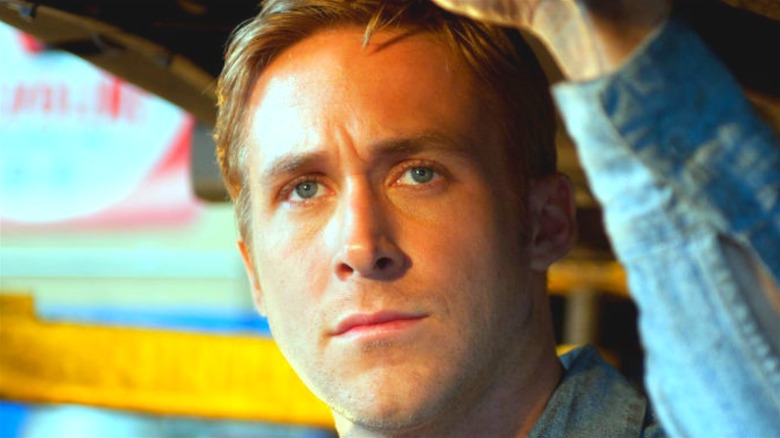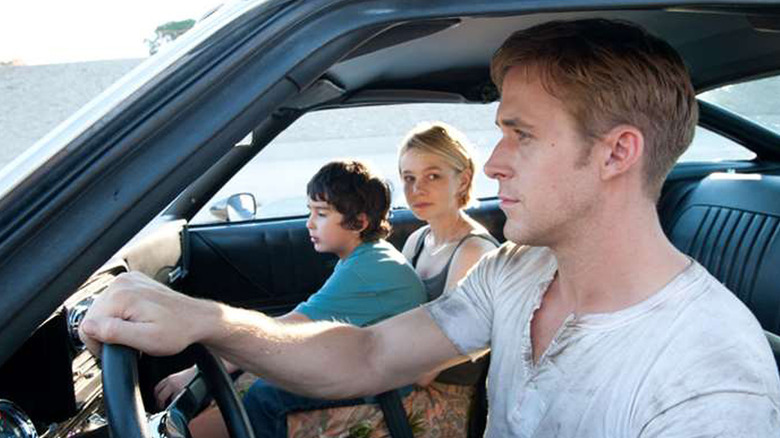The Ending Of Drive Explained
It's been a decade since Nicolas Winding Refn's "Drive" hit theaters in 2011, and it still holds up as a stylish and well-executed thriller that attempted to transform Ryan Gosling into an action star. After its premiere at the Cannes Film Festival, "Drive" received a 15-minute standing ovation, and Refn won that year's award for Best Director. Based on a novel by James Sallis, the many accolades "Drive" racked up are even more impressive when you consider the plot, which is basically a simple crime thriller that would have been at home in the 1970's or 80's. Ryan Gosling plays an unnamed character referred to as the Driver: by day he's a stunt driver and mechanic, by night he's a getaway driver who barely speaks and sometimes does jobs for a couple mobsters named Bernie (Albert Brooks) and Nino (Ron Perlman). It starts when the Driver develops a crush on his neighbor Irene (Carey Mulligan), who turns out to be married to a guy named Standard (Oscar Isaac), who's in with the Albanian mob. The Driver helps Standard with a robbery, but when it goes wrong Bernie and Nino try to kill everyone involved, which prompts the Driver to eliminate them one by one.
But there's a reason why a seemingly straightforward crime thriller won so many awards, and it's not just because of the stylish filmmaking — although the impressive chase sequence filmed in a single take alone makes the movie worth a watch. There's also more to it than just Ryan Gosling racking up a high body count, although it does have that, too. This is the ending of "Drive" explained.
In Drive, The Driver doesn't life happily ever after
Like the setup, the payoff for "Drive" isn't very complicated. After the robbery goes wrong and Standard dies, Bernie and Nino's goons start coming after the Driver and everyone he knows — which isn't very many people. The Driver's first priority is protecting Irene and her young son Benicio (Kaden Leos), who are the only truly innocent people in the whole situation. At one point, an assassin attacks them in an elevator and the Driver stomps him while Irene looks on, horrified.
After that, there's lots more violence and retaliation. The Driver kills Nino. Bernie kills Shannon (Bryan Cranston), who's the Driver's mentor. And finally, the Driver kills Bernie. This effectively removes the threat to the Driver and Irene, which would allow them to be together since Standard is now out of the picture. But that doesn't happen. Instead, the Driver drives off into the sunset.
In an interview with Indie Wire, Winding Refn said his main inspiration for "Drive" came from Grimms' Fairy Tales. Refn described fairy tales as "very specifically structured and condensed in their storytelling," adding that "all the characters are these archetypes, and there's always very few characters." That would explain why the characters in "Drive" are not only few in number but also not very uncomplicated. Irene and Benicio are good. Bernie and Nino are bad. And the Driver is somewhere in between. He's the hero of the story who lives by a code, which is to protect the innocent. But in order to protect Irene and Benicio, he's forced to commit so much violence that it warps him. He's not exactly bad, but he's too bad to be with someone as good as Irene. Like thousands of heroes before him, the Driver learns that protecting the good has a price.

